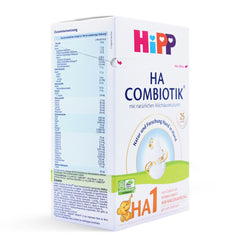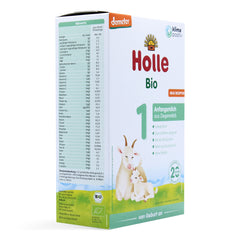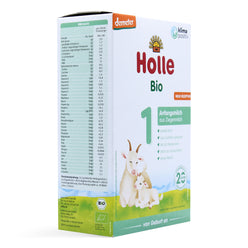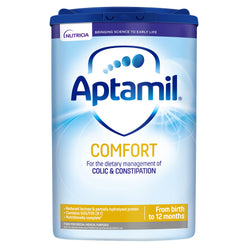Best Formulas For Gassy Babies
33 hours of research 5 minute read

Are you worried about your baby being gassy every time you feed them? Did you know that the milk they are being fed may be a reason for their constant irritability and fussing?
Babies who are allergic to some of the milk components or whose digestive system is unable to digest those components - may experience gassiness every time they feed. With increasing research over the past few years, a variety of infant formulas have been introduced that particularly target this issue in babies.
What Is The Importance Of An Infant Formula?
The mother’s breast milk is considered the safest and best source of nutrition for their baby - this may not always be possible. Studies show that this breast milk contains high levels of agents which can influence the functions of the baby’s digestive system and immune system. These bioactive agents may also help in their brain development and protect the baby against metabolic conditions like diabetes and obesity-associated diseases. (1)
According to WHO, infants should be fed by the mother via breast milk for the first six months of life. This is also backed up by the American Academy of Pediatrics, which recommends that infants be fed via breast milk for the first year of their life. (2) Breast milk contains the ideal nutritional value for the baby for the first years of their life. However, in addition to the breast milk, the baby may also be fed other baby foods by the time they reach six months of age, up to 12 months. However, breast milk may not be an option for every mother. This is when they have to rely on infant formulas, which are designed in a way that they resemble breast milk very closely.
Infant formulas are made by matching the national profile of human breast milk to provide the baby with optimal nutrition. (3) The base used for infant formula milk most often originates from cow or Soy milk. However, other ingredients and nutrients are often added to this and provide the baby with additional benefits. Additional contents like Iron, fat blends and nucleotides also allow the infant formula to resemble breast milk more closely.
What Causes Gassiness in Infants?
Infant gassiness and the associated crying and fussing have been closely linked to feeding time in a number of studies. These studies show that the higher the intestinal gas produced after milk intake, the greater may be the length of crying time in babies. (4) (5)
Hydrogen Gas Produced By Bacteria
The ‘gas’ produced after milk feeding is usually hydrogen gas, which causes the distension of the lower digestive tract, and is a source of distress for the baby. The hydrogen gas is being produced due to the presence of higher levels of intestinal bacteria and their induced fermentation of the milk. This was initially investigated in a study, which showed that babies with colic or gassiness have a higher breath hydrogen level at the start; however, as their condition resolves and they experience improvement in their symptoms, the hydrogen from their breath also starts to decrease. Hence at least 25 to 50% of the infants with gassiness have higher hydrogen baseline levels in their breath. (6)

Lactose Intolerance
Lactose intolerance is another cause often linked to excessive gassiness in babies after consuming lactose-containing milk. This was also investigated in studies showing that after infants are given lactose-containing milk, the hydrogen levels in their breath increase. These levels increased by 78% after six weeks and 89% after three months. (7) These results suggest that the malabsorption of lactose in the infant digestive tract may cause excess hydrogen to be produced. Hence, it was found that rescuing the lactose levels in the milk may prevent the uncomfortable symptoms felt by the infant when their digestive tract is unable to digest lactose. Furthermore, it was suggested that by adding artificial lactase to the milk, which is the enzyme responsible for digesting lactose, the babies might experience improvement in their symptoms. (8)
The Feeding Method
Sometimes, underfeeding or overfeeding the baby may also cause excess gas production in the baby. Another factor contributing to this condition is a lack of burping the baby. The new parents are recommended to consult a pediatrician about the correct way to feed the baby and what they should do before and after the baby has been fed.
Studies have shown that poor feeding techniques leading to infant gassiness are most commonly seen in firstborn babies, as the parents are unaware of what they should and should not do. (9) One way that experts have often described to cause the baby to burp is by turning them away by 45 degrees until their stomach is resting on the lower arm. The parent should make sure also to support the baby’s head, and the body part of the parent most commonly recommended for this is the elbow pit. The position of their legs is not important, and they may dangle on both sides of the arm. This particular position allows excess pressure to b applied to the baby’s digestive tract. By patting their back, the parent might be able to effectively relieve the gas build-up in their stomach in the form of a burp.
Allergy To Cow Milk
Allergy to cow milk is commonly seen in infants. This may present with a variety of symptoms, one of which is excess gassiness. This allergy is proposed to be related to the baby’s immune system. When allergic to some of the proteins found in cow milk, their immune system gets triggered, and an immune response is generated to remove that triggering protein from the body. Moreover, the next time a baby is given cow’s milk, the body will immediately recognize the protein present in it and release chemicals that will cause the symptoms of milk allergy.
The proteins in cow milk that are commonly responsible for cow milk allergy belong to the Casein and Whey group. The Casein Proteins include Aloha S1, Alpha S2, Beta, and Kappa Casein. On the other hand, the Whey proteins have Alpha-lactalbumin and beta-lactoglobulin. Therefore, individuals with a milk allergy are often allergic to all proteins and are recommended to shift to alternate milk types.
Best Infant Formulas For Gas
As mentioned previously, there are numerous reasons for gas in infants - most of which are caused by the specific infant formula being fed to the baby. This is why it is essential to consult a pediatrician who may suggest infant formulas that are either designed for babies with colic or gas or contain components considered safe for them.
Hypoallergenic Milk Formulas For Gas
Hypoallergic Milk formulas, also called Protein Hydrolysate formulas, are designed for infants who cannot tolerate both cow and soy milk-based formulas. These milk formulas contain proteins that have been broken down, either by complete hydrolysis or partial hydrolysis. These protein fragments are much smaller than those found in cow milk or soy milk formulas.
✓Contains Probiotics & Prebiotics
✓ No sugar, no corn syrup, no soy
✓ Hydrolyzed milk proteins reduce allergic reactions
✓ Popular for constipated babies
Check PriceGoat Milk Formulas For Gas
Infants with gas may also experience improvement by shifting to a goat milk-based formula. What differentiates goat milk from cow milk is that it contains lower levels of whey proteins. Since these Whey proteins may not be completely digested by the infant’s digested tract and lead to gassiness, bloating, and cramping, the absence of these from Goat milk might make it favorable for the baby.
✓ Clean formula ingredients
✓ No palm oil
✓ Contains DHA, & ALA
✓ Popular for babies alergic to cow's milk
Check PriceHiPP Dutch Formula For Gas
Because of the clean way in which HiPP Dutch is made and its nutritional values, many parents find HiPP Dutch to be an excellent choice for their gassy baby. With no nasty ingredients and the benefit of probiotics and prebiotics, a baby’s digestive system is able to digest HiPP Dutch relatively easier than other comparable formulas.
✓Contains Probiotics & Prebiotics
✓ No sugar, no corn syrup, no soy
✓ No starch
✓ HiPP's most popular formula
Check PriceHiPP Comfort Formula For Gas
HiPP Comfort was specifically created for babies who are gassy. This formula is super easy to digest and reduces the likelihood of gas buildup in the digestive system. It is one of the most popular formulas for gassy babies.
✓Contains Probiotics & Prebiotics
✓ No sugar, no corn syrup, no soy
✓ Reduced lactose with hydrolyzed milk protein
✓ Easy to digest formula for sensitive babies
Check Price✓Contains Prebiotics & DHA
✓ No sugar, no corn syrup, no soy
✓ Reduced lactose with hydrolyzed milk protein
✓ Easy to digest formula for sensitive babies
Check PriceAptamil Comfort Formula For Gas
Aptamil Comfort is specially designed to provide relief for babies experiencing discomfort due to gas and colic. Formulated with gentle ingredients, this baby formula helps ease digestive discomfort and reduces the likelihood of excessive gas formation. Aptamil Comfort Formula offers a comforting solution for parents seeking to soothe their baby's tummy and promote a happy, contented feeding experience.
✓Contains Prebiotics & DHA
✓ No sugar, no corn syrup
✓ Reduced lactose with hydrolyzed milk protein
✓ Popular for babies with colic and constipation
Check PriceOther Prescription Formula Options
Amino Acid-Based Milk Formulas
Amino acid-based milk formulas were introduced for babies unable to digest proteins, no matter how small the fragment may be. These infants are then recommended Amino acid-based milk formulas, free from any milk proteins and only free forms of amino acids, without any presence of peptides. These formulas are very difficult to find and not widely available without special help from a pediatrician.
Soy Milk Formulas
As the name suggests, Soy Milk formulas are made from soy proteins. They are particularly recommended for infants with galactosemia, or those who are deficient in the lactose digesting enzyme known as lactase. Due to a lack of lactose, these formulas prevent lactose intolerance and its associated symptoms. However, some infants who are entirely allergic to cow milk may also experience allergic reactions and gassiness with Soy Milk. For such cases, opting for the best soy formula for gassy babies might be beneficial in easing digestive discomfort. (10)
Formula for Gassy Babies
Some formulas may cause gassiness in the baby, which may be a source of distress for the baby and the parents. In these cases, they may switch to more digestion-friendly milk formula after consulting a pediatrician. The infant milk formulas often recommended for gassy babies include goat milk formulas, Soy Milk Formulas, hypoallergenic formulas, and amino acid-based formulas.
Switching to more digestion-friendly baby formula for gassy babies may alleviate discomfort and ensure a happier feeding experience for both the baby and the parents. By carefully selecting the best formula for colic and gassy babies, you can provide your little one with the relief they need for a happier and more contented feeding experience.
Most Popular Formula For Gassy Babies
References:
- Kalarikkal SM, Pfleghaar JL. Breastfeeding. [Updated 2021 Jul 26]. In: StatPearls [Internet]. Treasure Island (FL): StatPearls Publishing; 2022 Jan-. Available from: https://www.ncbi.nlm.nih.gov/books/NBK534767/
- Hoddinott, P., Tappin, D., & Wright, C. (2008). Breast feeding. BMJ (Clinical research ed.), 336(7649), 881–887. https://doi.org/10.1136/bmj.39521.566296.BE
- Stevens, E. E., Patrick, T. E., & Pickler, R. (2009). A history of infant feeding. The Journal of perinatal education, 18(2), 32–39. https://doi.org/10.1624/105812409X426314
- Moore, D. J., Robb, T. A., & Davidson, G. P. (1988). Breath hydrogen response to milk containing lactose in colicky and noncolicky infants. The Journal of pediatrics, 113(6), 979–984. https://doi.org/10.1016/s0022-3476(88)80567-5
- Ståhlberg, M. R., & Savilahti, E. (1986). Infantile colic and feeding. Archives of disease in childhood, 61(12), 1232–1233. https://doi.org/10.1136/adc.61.12.1232
- Fatheree, N. Y., Liu, Y., Ferris, M., Van Arsdall, M., McMurtry, V., Zozaya, M., Cai, C., Rahbar, M. H., Hessabi, M., Vu, T., Wong, C., Min, J., Tran, D. Q., Navarro, F., Gleason, W., Gonzalez, S., & Rhoads, J. M. (2016). Hypoallergenic formula with Lactobacillus rhamnosus GG for babies with colic: A pilot study of recruitment, retention, and fecal biomarkers. World journal of gastrointestinal pathophysiology, 7(1), 160–170. https://doi.org/10.4291/wjgp.v7.i1.160
- Lust, K. D., Brown, J. E., & Thomas, W. (1996). Maternal intake of cruciferous vegetables and other foods and colic symptoms in exclusively breast-fed infants. Journal of the American Dietetic Association, 96(1), 46–48. https://doi.org/10.1016/s0002-8223(96)00013-2
- Infante, D., Segarra, O., & Luyer, B. L. (2011). Dietary treatment of colic caused by excess gas in infants: biochemical evidence. World journal of gastroenterology, 17(16), 2104–2108. https://doi.org/10.3748/wjg.v17.i16.2104
- Fazil M. (2011). Prevalence and risk factors for infantile colic in District Mansehra. Journal of Ayub Medical College, Abbottabad : JAMC, 23(2), 115–117.
- Martin, C. R., Ling, P. R., & Blackburn, G. L. (2016). Review of Infant Feeding: Key Features of Breast Milk and Infant Formula. Nutrients, 8(5), 279. https://doi.org/10.3390/nu8050279

















Juana -
I think my baby has been one of the gassiest babies out there! It was frustrating and tiring. We tried different methods to alleviate the condition. From massages, burping, chiropractors, and bottle type changes, still the gassiness is there! We were then introduced to trying a different baby formula for gassiness. My best friend recommended trying HiPP Comfort European formulation. She said it contains prebiotics, there is no sugar, no corn syrup, and no soy. Also, she claims it is easy to digest as it has reduced lactose with hydrolyzed milk protein. It might be perfect for my baby. Due to desperation, I bought one pack to try, and the rest is history. My baby loves it instantly. I think it comforted her. The gassiness can be easily addressed with a simple burp and pat on the back. He is passing stools more easily. I have decided to be on a subscription, and that is the best thing I have done. Loving the formula so far!
Elmer Creech -
As a parent who has had a very gassy newborn, I found the Organic Life Start website really useful and encouraging. It thoroughly and accurately outlined the common reasons for gas in babies, allowing me to better understand what my child was going through. I appreciated how the site provided specific formula options that are mild on sensitive stomachs, as selecting one might be overwhelming. The thorough pros and cons for each formula helped me narrow down the best option for my baby. I also enjoyed how the instructions offered feeding tips and bottle practices to help reduce gas, rather than just focusing on the formula. After switching to one of the recommended formulas, my baby’s comfort and sleep improved significantly. Reading about other parents’ experiences in the post helped me feel more supported and less stressed. Overall, Organic Life Start helped our family during a difficult period. Thank you also, Holle Goat, you are our lifesaver!!!!
Lana M -
I’d love to hear more about lactose intolerance in babies! As a parent, it can be so hard to tell the difference between normal gassiness and signs of something more like a sensitivity or intolerance. My baby has been extra fussy after feeds, with a lot of gas and discomfort, and I’ve started wondering if lactose might be the issue. But then I second-guess myself—how do you even know if it’s really lactose intolerance or just part of their digestive system maturing? I’d really love to hear from other parents who’ve gone through this. What symptoms did your baby have? Did switching to a lactose-free or low-lactose formula help, and how quickly did you notice a difference? It’s such a stressful guessing game, and hearing real-life stories would really help make the next steps feel less overwhelming.